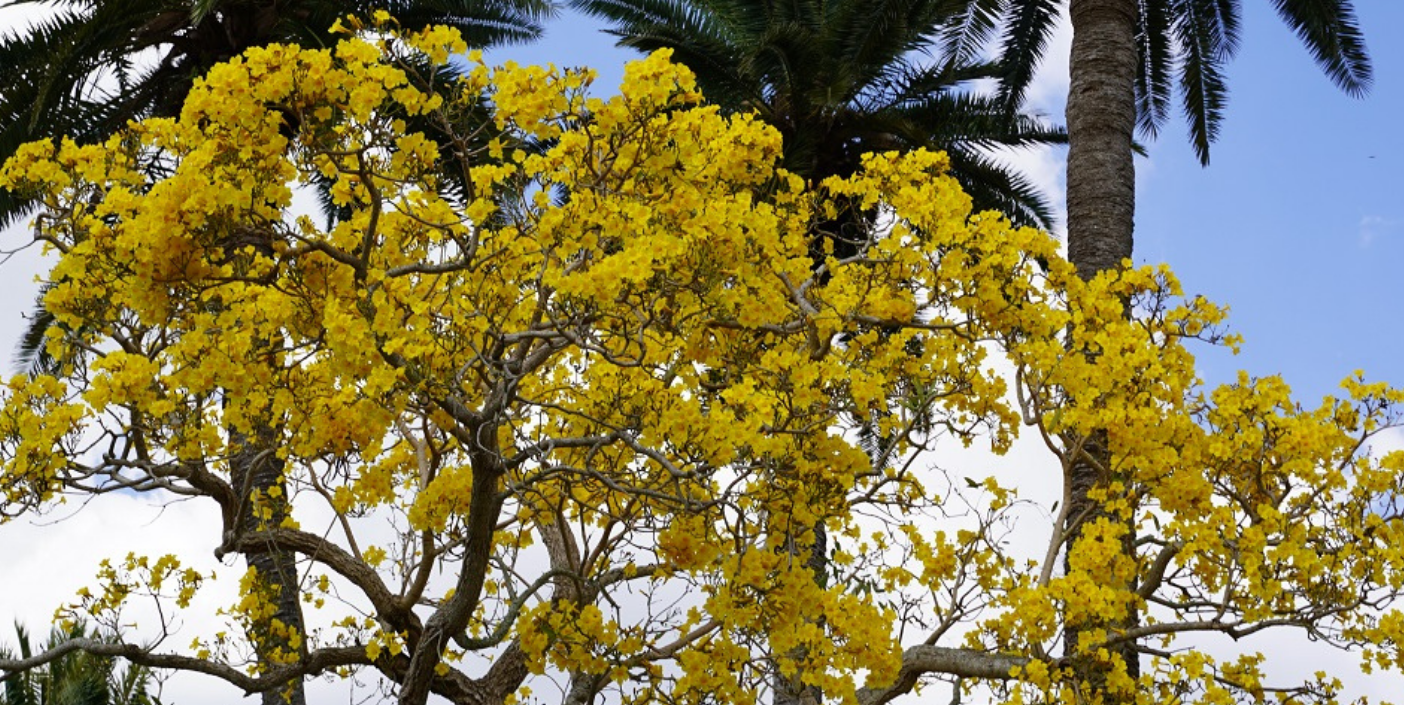
You may be tempted to think that trees of the tropics are forever in full leaf. Not so! We have a number of deciduous trees — those that shed their leaves at the end of the growing season. We don’t get the glory of fall, but we get something equally (if not more) spectacular in the spring. Flowers.
That’s right. A combination of factors, including warming temperatures and lack of water, triggers several species of trees to bloom this time of year. They include the kapok, silver trumpet tree, double buttercup tree, and the peach blossom cassia.
Kapok tree (Bombax ceiba)

The kapok tree, also called the silk cotton tree, located by the Grove, is a majestic tree typically found within tropical rainforests and is native to China, Indonesia, and Malaysia. It can grow to more than 150 feet tall.

It has red, cup-shaped flowers and green rounded leaves that can be used as a vegetable in curry. Gum from the tree’s inner bark was used medicinally to treat coughs, influenza, and even snake bites. The most important item of the kapok tree is its fiber that comes from the seed hair of its fruit. This silk fiber is used for life preservers, pillows, mattresses, and upholstery.
Silver trumpet tree (Tabebuia aurea)

The silver trumpet tree native to Argentina, Brazil, and Paraguay, is located in the Karen and Scott Florida Garden and the LaGrippe Orchid Garden.

These evergreen trees can reach 25 feet and showcase contorted branches with silver foliage and a trunk with silvery bark. When these trees are in bloom, a bevy of 3-inch, trumpet-shaped blooms arrive in golden yellow clusters. These blooms arrive just after its leaves drop.
Double buttercup tree (Cochlospermum vitiflolium ‘Flore Pleno’)

The double buttercup tree, native to Mexico and Central America, is in bloom in the Karen and Scott Florida Garden, featuring vibrant yellow, cupped flowers. This ornamental tree can grow up to 40 feet and has asymmetrical branches with very few leaves and a leaning trunk. Bees flock to this tree to drink its sweet nectar.
Peach blossom cassia (Cassia bakeriana)

The peach blossom cassia, also called the Pink Shower Tree, is a sight to see in the Karen and Robert Scott Florida Garden. Native to Thailand and Myanmar, this tree can grow between 20 – 30 feet tall. This ornamental tree attracts birds and bees. It has fragrant flowers with yellow stamen, and its petals will emerge as pink and fade to lighter pink than a white hue.
Vice President of Horticulture Brian Galligan notes that people unfamiliar with the tropics may be tempted to water and fertilize these deciduous trees, thinking something is awry as they defoliate. Don’t do it, he says.
“You want them to stay dry and stay ‘unhappy.’ That’s when they flower.”
Enjoy this unique-to-the-tropics sign of spring!
About the Author

Darby Kordonowy is the Content Coordinator for Naples Botanical Garden. Darby loves learning! Her favorite plants are the Jade vine (Strongylodon macrobotrys) and the Camellia japonica ‘Pink Perfection’. She is an amateur bird watcher!

